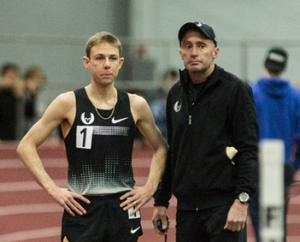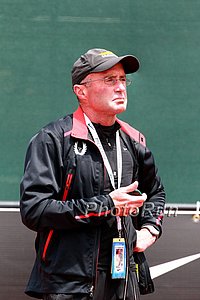5 Thoughts on NY Times Report that Alberto Salazar Was Banned by SafeSport For Sexual Assault
By LetsRun.com
January 31, 2022
In December 2021, former Nike Oregon Project coach Alberto Salazar was ruled permanently ineligible by the U.S. Center for SafeSport for sexual misconduct. At the time, however, no details existed about what, specifically, Salazar had been banned for. Though Salazar is in the midst of a four-year ban from the US Anti-Doping Agency for multiple anti-doping rules violations and had been accused of body shaming by multiple former athletes, he had never been the subject of public sexual misconduct allegations.
Today, the allegations came to light. The New York Times (NYT) reported that an arbitrator heard Salazar’s appeal of his SafeSport ban in December, and the Times viewed a summary of the arbitrator’s decision. That decision upheld three of Salazar’s four violations of the SafeSport code. The most damning, according to the Times, was the finding that Salazar twice “penetrat[ed] a runner with a finger while giving an athletic massage.” The third violation was for “sexually inappropriate comments and actions.”
The NYT reported that Salazar “denied the accusations and said he did not speak with or see the runner on the days in question. The arbitrator did not find Salazar’s explanation credible, and accepted his accuser’s version of events.”
The arbitrator’s decision has not been made public – indeed, virtually no public information about Salazar’s case exists, other than that he has been ruled permanently ineligible for sexual misconduct. The NYT noted that the arbitrator’s decision had enough details to identify Salazar’s accuser, but the NYT elected not to publish that information as it generally does not identify potential victims of sexual assault.
Here are LetsRun.com’s biggest takeaways after today’s developments.
1) Sexual assault takes this to a whole new level
Up until this point, the most serious law Alberto Salazar may have violated likely would have been prescription drug laws. Sexual assault is something different entirely. It is a felony. Perpetrators often go to prison.
Our inclination is to say these “allegations” are very serious. But at this point, they aren’t allegations. They’re more than that.
Salazar has not been charged with anything criminally, but SafeSport found the allegations credible and imposed a lifetime ban on Salazar. An arbitrator then ruled with a “preponderance of evidence” (more likely than not, 51% vs 49%) standard that the sexual assault took place.
The fact that something as serious as this, so far beyond the pale of anything else previously alleged, could be found against a man who has been in the limelight of the sport for so long is truly shocking.
2) SafeSport needs to improve its process and transparency
Some may have rejoiced when Salazar was banned by SafeSport in December, but the whole process left a sour taste in our mouth. News of Salazar’s permanent ban came two days before Christmas, and there was no announcement of any kind. The only way anyone knew that Salazar had been permanently banned was because SafeSport updated its online database. It listed “sexual misconduct” as the reason for Salazar’s ban but provided no information about any of the allegations against Salazar. Was he banned for fat-shaming or something more serious? No one had any idea.
When LetsRun reached out to SafeSport in December, it would not even confirm whether Salazar had appealed his case, writing, “the Center does not comment on matters to protect the integrity of the process.”
That is not how a body like SafeSport should operate. In fact, a blanket refusal to comment on any aspect of its cases – even once a final arbitration ruling has been made – is the opposite of “protecting the integrity of the process.”
SafeSport has been entrusted with a significant amount of power, including the ability to impose lifetime bans. When a body has that much power, the public has to be able to trust that that body’s process is fair. Providing zero transparency on a major case like Salazar’s does little to engender that trust; if anything, it sows doubt about the legitimacy of the process.
Given that SafeSport handles allegations of sexual abuse in Olympic sports, we understand that some of their cases require a certain degree of privacy. But in the Salazar case, it essentially amounted to “full privacy” as no one outside of those involved in the case knew what was going on.
After today’s NY Times story, we now know that Salazar was accused of multiple instances of penetrating a runner while giving a massage, that he denied the allegations, stating that he did not even see the athlete in question on those days, and that an arbitrator did not find his explanation credible.
We are glad that the sexual assault allegation is now public – in December, we called for a summary like the one we got today at a bare minimum in future cases – but it shouldn’t require a possible violation of federal law to create more transparency (see point #5).
3) We are glad Salazar was not handed a lifetime ban for fat-shaming
 When Salazar was banned for “sexual misconduct” in December, we wondered whether, through a creative interpretation of the rules, Salazar had been handed a lifetime ban for fat-shaming. If that was the case, we argued, it was a gross overreaction.
When Salazar was banned for “sexual misconduct” in December, we wondered whether, through a creative interpretation of the rules, Salazar had been handed a lifetime ban for fat-shaming. If that was the case, we argued, it was a gross overreaction.
Now we know there was a much more serious charge. And in the end, Salazar was not banned for fat-shaming at all – the Times reported that the SafeSport violation involving “inappropriate comments about another runner’s weight and body shape” was not upheld by the arbitrator. That would explain why Salazar’s initial SafeSport suspension listed “emotional abuse” as one of the reasons for his ban in July 2021 but “emotional abuse” was removed after his appeal was heard in December.
4) Alberto Salazar told The New York Times he’d like to provide more facts to defend himself but is constrained by SafeSport’s confidentiality rules. We don’t think that’s true.
The NY Times piece includes the following paragraph:
Salazar wrote that the SafeSport process was unfair and “lacked due process protections,” and if there was a “full and fair trial” there would have been a different result. He also said he would like to provide more facts about the “falsity of the allegations against me” but was constrained by SafeSport’s confidentiality rules.
What Salazar is claiming — that he can’t defend himself — doesn’t appear to be true. The 2021 SafeSport Code (XI)(S) clearly states that Salazar isn’t restricted in discussing the process as long as he doesn’t identify the accuser or publicly disclose an accuser’s identifying information:
Additionally, subject to the Abuse of Process provision (including the prohibition on identifying a Claimant), the Center does not impose any restrictions on a Claimant’s or Respondent’s ability to discuss the incident, their participation in the Center’s process, or the outcome of that process.
It’s possible that Salazar may feel that it would be hard to properly defend himself without providing enough facts that would make it easy for the accuser to be identified, but we were relieved to learn that the SafeSport code specifically does not prohibit the accused from publicly trying to defend themselves.
5) The leaking of the summary of the arbitrator’s reasoning to The New York Times shouldn’t be a violation of federal law
We are glad the New York Times brought the decision to light, but doing so shouldn’t be a possible violation of federal law.
The 2021 SafeSport code says, “The Center’s decisions, investigation reports, and other work product are confidential under 36 USC § 220541(f)(4)(C),” which in turn says:
(C) Work product.- (i) In general.-Any decision, report, memorandum, work product, notes, or case file of the Center- (I) shall be confidential; and (II) shall not be subject to discovery, subpoena, or any other means of legal compulsion in any civil action in which the Center is not a party to the action.
The document from which the details in the NY Times story are drawn is “a document summarizing the arbitrator’s reasoning, which was prepared for U.S.A. Track & Field and the United States Olympic & Paralympic Committee.” That would seem to qualify as a memorandum and thus subject to confidentiality. Leaking such a document, therefore, would appear to be a violation of federal law.
It shouldn’t be. SafeSport needs a lot more transparency as this case shows.



